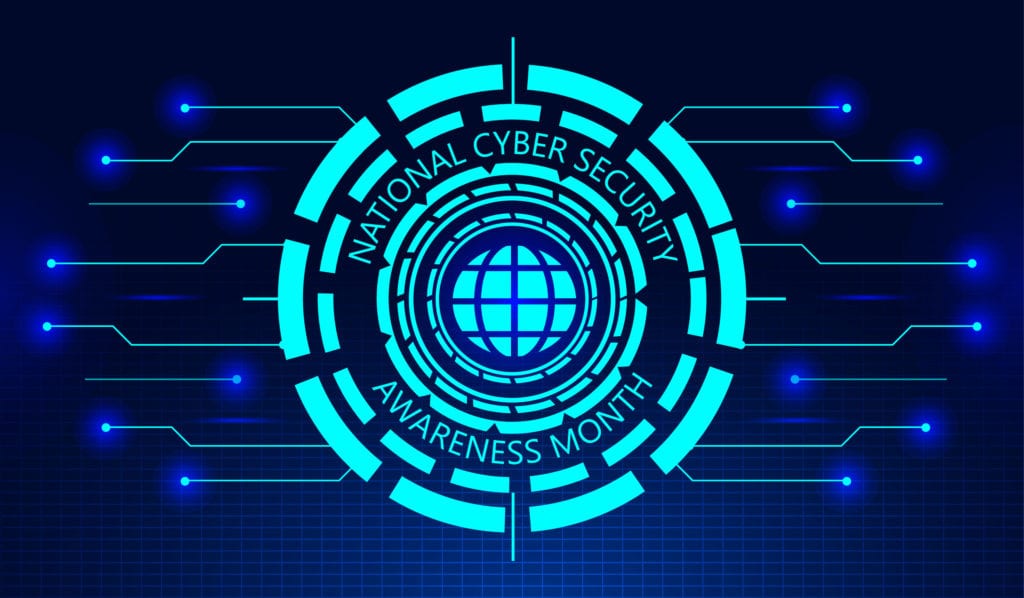
While cybersecurity is important every day, each October there is a little more emphasis added during National Cybersecurity Awareness Month (NCSAM).
This month is focused on all types of device security, from computers to mobile devices to IoT devices. It’s important to understand how each of these types of devices can be at risk in a home or office if you don’t have the right Framingham IT support and security.
Computers used to be the main device that people worried about. They would make sure they had antivirus installed and take other security precautions, like keeping software updated.
But not as much attention is paid to the security of mobile devices and IoT devices (like smart speakers, doorbell security cameras, etc.), but they’re making up a bigger part of home and business networks.
Mobile devices now make up 60% of the endpoint devices on business networks.
This year’s NCSAM focus on devices is a perfect time to review some of the safety best practices you should be taking for all your electronic devices.
Keep All the Devices You Use Secure from Online Threats
The main theme of this year’s National Cybersecurity Awareness Month is: Do Your Part. #BeCyberSmart and it notes that cybersecurity is everyone’s responsibility.
But it’s also just good sense with all the dangers out there, such as:
- Identify theft
- Financial theft
- Data breaches
- Account takeovers
- Ransomware
- Malware
- Social engineering/phishing
Here are ways you can apply NCSAM’s message of “If you connect it, protect it” to your home and work life this month (and all year long).
Mobile Device Security
Smartphones and tablets are taking over a larger percentage of screen time from computers every year. They’re convenient to use anywhere, get more powerful all the time, and have the ability to run most business apps.
But mobile device security often lags behind that of PCs and many don’t have enough protection.
During the first half of 2019, mobile banking malware attacks increased 50%.
Here are some of the ways you can protect your mobile devices from a breach:
- Install mobile antivirus/anti-malware
- Only download apps from an official app store (iTunes/Google Play)
- Keep your mobile device operating system and apps updated
- Businesses should use a mobile device manager (like Microsoft Intune)
IoT Device Security
IoT devices is a category that gets larger all the time. Basically, this is any smart gadget that is internet connected, other than a computer or mobile device.
These types of devices have been multiplying and they’re a prime target for hackers because users often don’t take some of the basic steps they need to protect them.
IoT devices include things like:
- Routers
- Voice speakers (like Alexa and Google Home)
- Doorbell cameras and other security systems
- Smart thermostats
- Smart lighting
- Internet connected appliances
These types of devices are often not updated regularly because users often have to go looking for an update. Most home and business users rarely log into their Wi-Fi router settings after first setting the device up, so they never see when a critical security update is waiting to be applied.
98% of all IoT traffic is unencrypted, making it easy for hackers to intercept. Additionally, 57% of IoT devices are currently vulnerable to medium or high-severity attacks.
Here are some of the best practices you should take to secure IoT devices:
- Immediately change the default username and password when setting up the device
- Change the SSID (device’s network name) to something non-descript (no model or brand information)
- Disable PnP to prevent this feature being exploited by hackers
- Make sure you regularly check your device for security updates
Desktop & Laptop Security
With more people in Massachusetts and around the country working from home than ever before, companies and at home employees need to be hyper-sensitive about computer security.
This includes extending any managed computer security services used at the office to remote employee computers. It also means creating a handbook that can guide remote workers on how to manage security for their desktop or laptop.
Standards that you should be taking with each computer at home or at work include:
- Installing antivirus/anti-malware
- Web protection to block malicious websites
- Keeping the operating system, firmware, and software updated
- Using a secure network or a VPN
- Password protecting your screen and device
Wearables Security
A newer type of device cybersecurity to worry about is with wearables. Fitbits, Apple Watches, and other smart wearable technology is becoming more popular as prices come down and capabilities increase.
But these are by far the easiest of all your devices to lose or have stolen, yet they can also be logged into your email, access a mobile banking app, and more.
Some of the steps you want to take to secure your internet connected wearables include:
- Using a passcode lock on the device
- Use a loss control app that can track your device and wipe it remotely if needed
- Keep wearables as physically secured as you do your wallet and credit cards
Get Worry-Free Computer Security with Cloud Care Pro™
Cloud Care Pro™ from Pro Tech Guy can make computer device security much easier by bundling protections like managed security updates and antivirus/anti-malware.
Contact us today to learn more! Call 508-364-8189 or reach us online.
